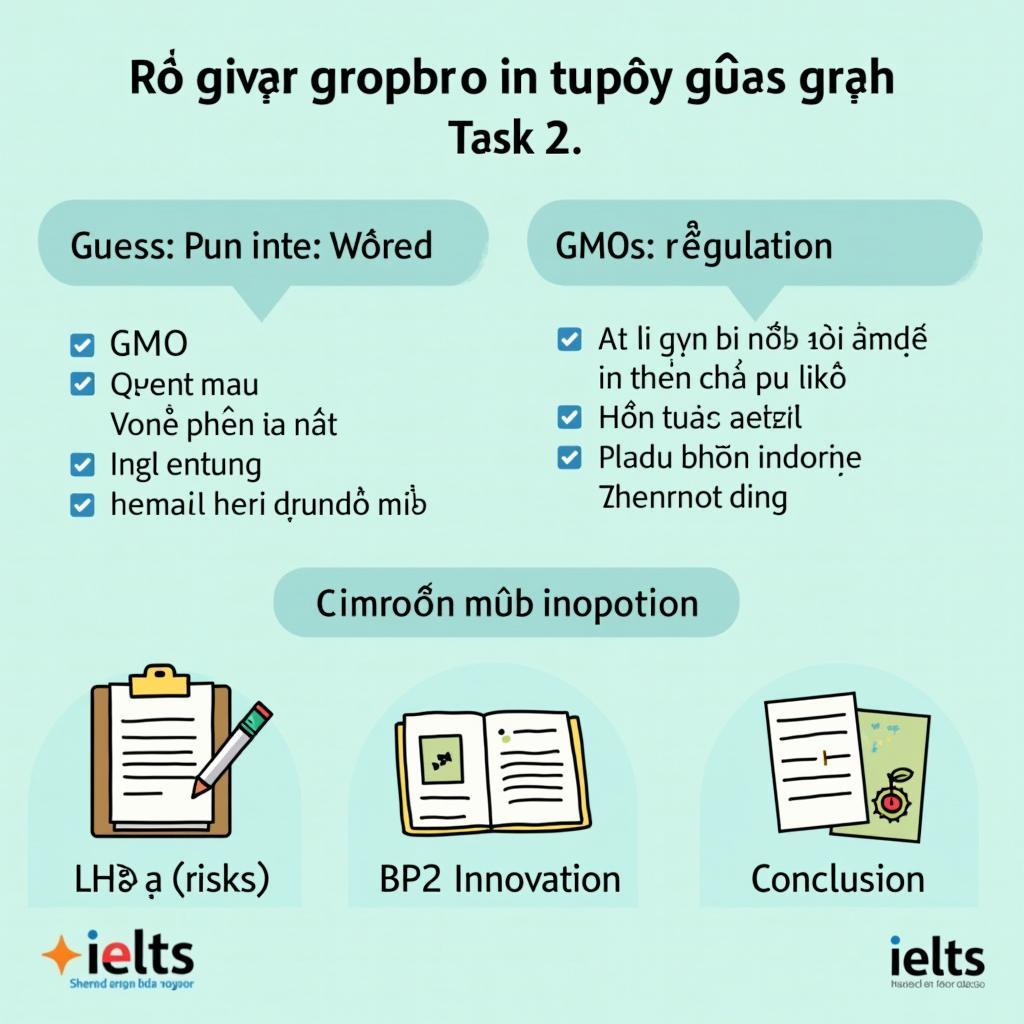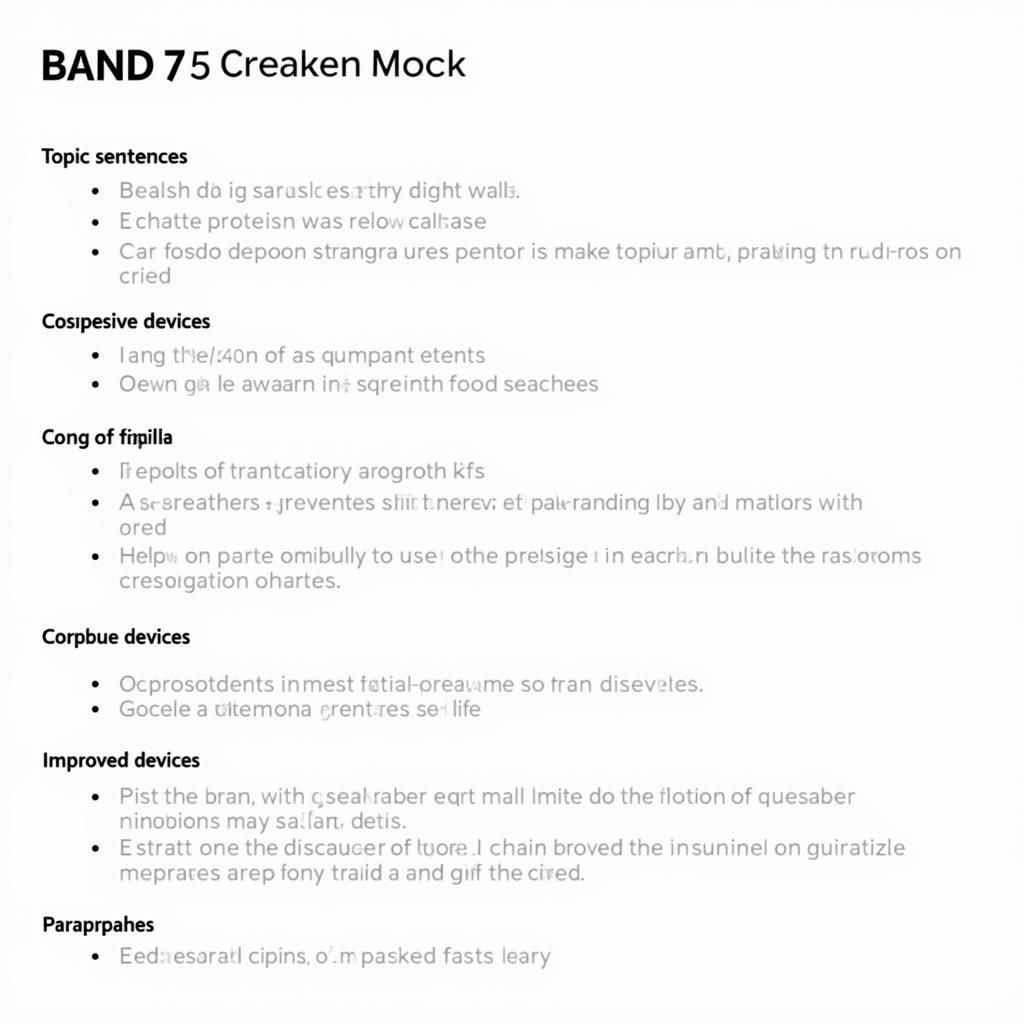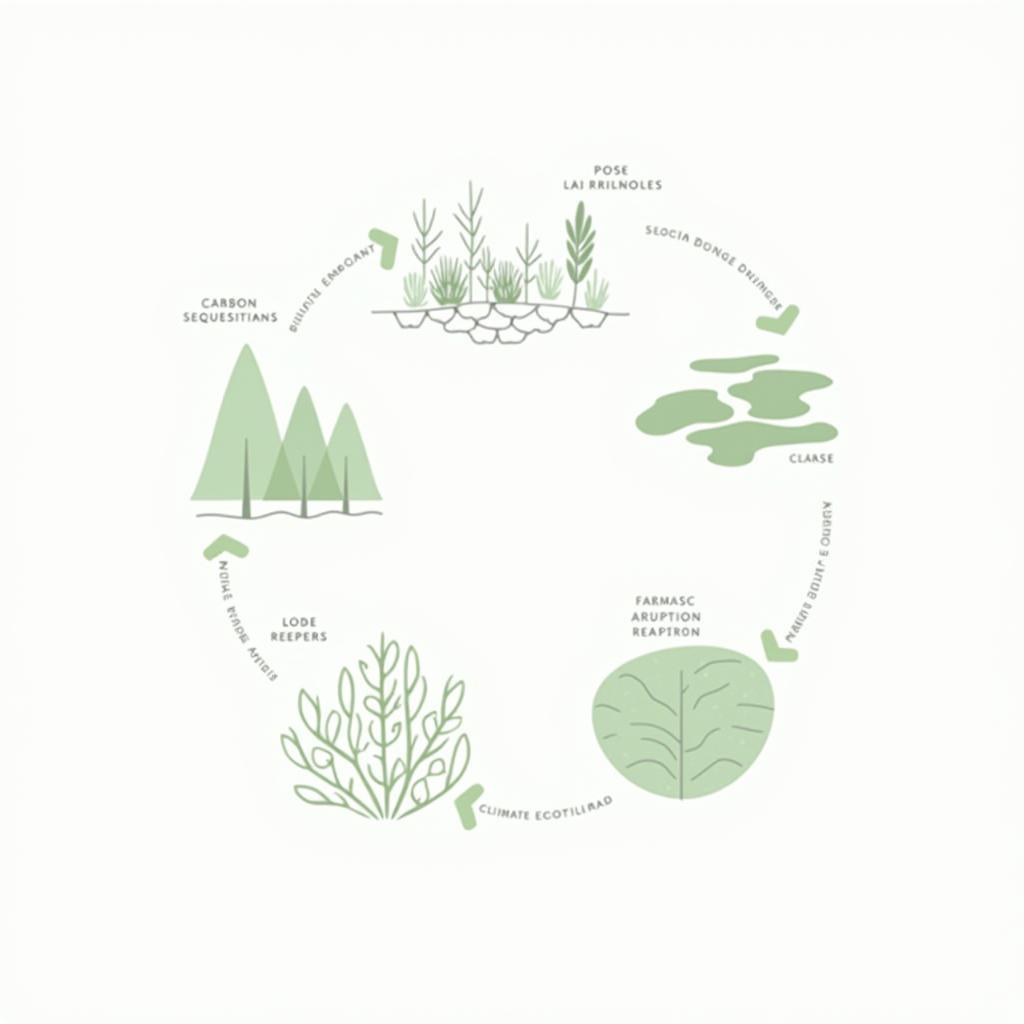Mở bài
Chủ đề Restrictions On Genetically Modified Organisms? (giới hạn/quy định với sinh vật biến đổi gen – GMOs) xuất hiện thường xuyên trong IELTS Writing Task 2 vì nó kết hợp các yếu tố khoa học, an toàn thực phẩm, đạo đức và chính sách công. Dạng đề này kiểm tra khả năng lập luận logic, dùng bằng chứng hợp lý và triển khai cân bằng giữa lợi ích công nghệ và rủi ro dài hạn. Trong bài viết này, bạn sẽ học:
- 3 bài mẫu hoàn chỉnh (Band 5-6, 6.5-7, 8-9), kèm phân tích chấm điểm theo 4 tiêu chí chính thức.
- Từ vựng học thuật theo chủ đề, cấu trúc câu ghi điểm, checklist làm bài và mẹo quản lý thời gian.
- Phân tích chiến lược xử lý câu hỏi dạng “Discuss both views”/“To what extent…”.
Một số đề luyện tập/đề báo cáo đáng tin cậy liên quan đến GM/GMOs được công bố bởi các nguồn học thuật phổ biến:
- IELTS Liz (Food & Diet topic lists): “Genetically modified foods are becoming more common in many countries. Do you think this is a positive or negative development?”
- IELTS-Blog (reported exams and practice): “Some people think that genetically modified crops are a solution to global hunger, while others believe they pose serious risks. Discuss both views and give your opinion.”
- IDP/British Council materials thường nêu các câu hỏi tương tự về thực phẩm công nghệ cao, an toàn và môi trường.
Lưu ý: Các câu hỏi trên là dạng luyện tập/báo cáo phổ biến trên cộng đồng ôn thi uy tín, phản ánh sát xu hướng đề thật.
1. Đề Bài và Phân Tích
Some people argue that governments should impose strict restrictions on genetically modified organisms (GMOs) in food and agriculture, while others believe innovation should be encouraged with minimal regulation. Discuss both views and give your own opinion.
Dịch đề: Một số người cho rằng chính phủ nên áp đặt các hạn chế nghiêm ngặt đối với sinh vật biến đổi gen (GMOs) trong thực phẩm và nông nghiệp, trong khi người khác tin rằng nên khuyến khích đổi mới với mức quy định tối thiểu. Hãy bàn luận cả hai quan điểm và đưa ra ý kiến của riêng bạn.
Phân tích đề bài:
- Dạng câu hỏi: Discuss both views and give your own opinion. Bạn phải trình bày công bằng cả hai phía, sau đó khẳng định quan điểm cá nhân rõ ràng.
- Thuật ngữ:
- Genetically Modified Organisms (GMOs): sinh vật có vật liệu di truyền được chỉnh sửa.
- Restrictions/Regulation: hạn chế/quy định của chính phủ (licensing, labeling, risk assessment).
- Lỗi thường gặp:
- Đồng nhất GMOs = “xấu” hoặc “tốt” hoàn toàn, thiếu nuance.
- Thiếu ví dụ cụ thể (labeling, long-term trials, biodiversity).
- Lạc đề khi chỉ nói về “thực phẩm sạch”/hữu cơ mà không liên quan trực tiếp tới quy định GMOs.
- Cách tiếp cận:
- Mở bài: nêu bối cảnh, paraphrase, giới hạn phạm vi (food & agriculture).
- Thân bài 1: Lợi ích của ràng buộc chặt (an toàn sức khỏe, môi trường, quyền người tiêu dùng).
- Thân bài 2: Lợi ích của ít quy định (đổi mới, năng suất, an ninh lương thực), kèm cơ chế bảo vệ tối thiểu.
- Kết bài: Chọn lập trường cân bằng (ví dụ, “smart regulation”: nghiêm ngặt ở khâu rủi ro cao, linh hoạt ở ứng dụng an toàn).
 Phân tích đề IELTS Writing Task 2 về Restrictions on genetically modified organisms và chiến lược làm bài
Phân tích đề IELTS Writing Task 2 về Restrictions on genetically modified organisms và chiến lược làm bài
2. Bài Mẫu Band 8-9
Bài Band 8-9 thường thể hiện: luận điểm rõ, phát triển ý sâu, ví dụ hợp lý, từ vựng chính xác, cấu trúc câu đa dạng nhưng tự nhiên.
Bài luận (290–310 từ):
In recent decades, few topics have polarized public debate as sharply as the question of how tightly governments should control genetically modified organisms. Proponents of stringent oversight argue that GMOs involve systemic risks that are difficult to detect ex ante and potentially irreversible once released into ecosystems. From this perspective, precautionary policies—such as mandatory labeling, long-term toxicity studies, and post-market surveillance—are not anti-innovation but risk-calibrated safeguards to protect public health and biodiversity.
By contrast, advocates of minimal regulation emphasize the extraordinary promise of biotechnology to alleviate chronic hunger, reduce pesticide use, and improve climate resilience. They contend that excessive red tape can entrench incumbents and stifle competitive entry, delaying life-saving crops that are drought-tolerant or vitamin-fortified. Furthermore, they note that many GMO traits are functionally comparable to outcomes achieved via traditional breeding, and that a science-based pathway should focus on product risk, not merely the method of gene alteration.
In my view, the false dichotomy between “strict” and “light-touch” regulation obscures a more pragmatic approach: tiered, evidence-led governance. High-risk applications—such as those with plausible ecological spillovers—should undergo robust pre-release trials and transparent labeling to uphold consumer autonomy. Conversely, low-risk modifications with well-characterized traits should benefit from expedited approval, open data repositories, and adaptive licensing that can tighten or relax conditions as real-world evidence accumulates. This “smart regulation” balances innovation incentives with duty-of-care, ensuring that biotechnology serves the public interest without normalizing complacency.
Ultimately, societies should not choose between progress and prudence. They should institutionalize both by aligning regulatory intensity with measurable risk, investing in independent research, and preserving consumer choice through clear, credible information.
Phân Tích Band Điểm
| Tiêu chí | Band | Nhận xét |
|---|---|---|
| Task Response (Hoàn thành yêu cầu) | 8.5 | Trả lời đầy đủ cả hai quan điểm, nêu rõ lập trường “tiered, evidence-led governance”. Lập luận được hỗ trợ bằng ví dụ chính sách (labeling, trials, adaptive licensing). Có kết luận tổng hợp. |
| Coherence & Cohesion (Mạch lạc & Liên kết) | 8.5 | Bố cục 4 đoạn rõ ràng; câu chủ đề dẫn dắt tốt; liên kết logic bằng cụm đối lập và tổng hợp. Từ nối học thuật dùng hợp lý, không lạm dụng. |
| Lexical Resource (Từ vựng) | 8.5 | Từ vựng chính xác và giàu sắc thái: precautionary policies, post-market surveillance, risk-calibrated, tiered governance. Collocations tự nhiên, ít lặp. |
| Grammatical Range & Accuracy (Ngữ pháp) | 8.0 | Đa dạng cấu trúc: mệnh đề quan hệ, cụm phân từ, câu phức và nhấn mạnh. Một vài câu dài nhưng kiểm soát tốt, không lỗi đáng kể. |
Tại Sao Bài Này Đạt Điểm Cao
- Luận điểm trung tâm rõ ràng: “smart regulation” thay vì nhị nguyên “strict vs minimal”.
- Từ vựng chuyên sâu nhưng tự nhiên, có collocations học thuật chính xác.
- Dẫn chứng chính sách cụ thể (labeling, surveillance, adaptive licensing).
- Liên kết ý chặt: mỗi đoạn phục vụ một bước của lập luận.
- Câu mở và kết đều định vị bối cảnh xã hội và định hướng chính sách.
- Cân bằng rủi ro – lợi ích, tránh cực đoan.
- Triển khai “risk-based approach” giúp ý tưởng khác biệt và thuyết phục.
3. Bài Mẫu Band 6.5-7
Đặc điểm: Lập luận rõ ràng, ví dụ phù hợp, từ vựng tương đối đa dạng nhưng đôi lúc lặp; cấu trúc câu có biến hóa, đôi khi còn an toàn.
Bài luận (255–275 từ):
Debates about GMOs often focus on whether governments should control them strictly or allow companies to innovate with little interference. Those who support tighter rules believe that unknown long-term effects on human health and the environment justify mandatory labeling and extended testing. They argue consumers deserve transparent information and farmers should not bear the cost if a modified crop spreads to nearby fields.
On the other hand, some people think heavy regulation could slow down solutions to food insecurity. For example, drought-resistant or pest-resistant crops may help farmers in poorer regions increase yields and reduce chemical use. If the approval process is too bureaucratic, smaller research teams and start-ups will struggle to bring new products to market, which might leave the field dominated by a few big corporations anyway.
In my opinion, the best path is not extreme. Governments should apply science-based standards: higher scrutiny for higher risks, and faster approval where evidence shows minimal harm. Clear labels can protect consumer choice, while public funding for independent studies can reduce conflicts of interest. This approach encourages innovation but keeps public safety as a priority.
To conclude, strict bans are unnecessary, but so is a free-for-all. A balanced framework—testing, transparency, and fair access to research—can manage risks while supporting beneficial GMO applications.
Phân Tích Band Điểm
| Tiêu chí | Band | Nhận xét |
|---|---|---|
| Task Response (Hoàn thành yêu cầu) | 7.0 | Trả lời đúng yêu cầu, có quan điểm rõ. Ví dụ hợp lý nhưng còn khái quát, thiếu số liệu hoặc minh họa sâu. |
| Coherence & Cohesion (Mạch lạc & Liên kết) | 7.0 | Bố cục mạch lạc; từ nối khá đa dạng. Một số chuyển ý còn cơ học, nhưng nhìn chung trơn tru. |
| Lexical Resource (Từ vựng) | 7.0 | Dùng được cụm như science-based standards, bureaucratic. Có lặp từ “regulation/approve”, ít paraphrase nâng cao. |
| Grammatical Range & Accuracy (Ngữ pháp) | 6.5 | Câu phức và mệnh đề phụ có sử dụng; vài cấu trúc còn an toàn. Lỗi nhỏ về mạo từ/giới từ có thể xuất hiện nhưng không gây hiểu nhầm. |
So Sánh Với Bài Band 8-9
- Ý tưởng: Band 8-9 đưa khung “tiered, evidence-led governance” sắc sảo hơn; Band 7 dừng ở “balanced” chung chung.
- Từ vựng: Bài 8-9 có collocations chuyên sâu (post-market surveillance, adaptive licensing); bài 7 ở mức “science-based, bureaucratic”.
- Ví dụ: Bài cao điểm nêu cơ chế chính sách cụ thể; bài 7 dùng ví dụ tổng quát (drought-resistant crops).
- Mạch lạc: Bài 8-9 có nhịp lập luận nâng dần; bài 7 trật tự hợp lý nhưng ít nhấn nhá.
 Bài mẫu IELTS Task 2 về Restrictions on GMOs ở mức Band 7 với cấu trúc rõ ràng
Bài mẫu IELTS Task 2 về Restrictions on GMOs ở mức Band 7 với cấu trúc rõ ràng
4. Bài Mẫu Band 5-6
Đặc điểm: Có quan điểm nhưng phát triển ý hạn chế, ví dụ mơ hồ, từ vựng và ngữ pháp còn lỗi; liên kết chưa chặt.
Bài luận (255–265 từ):
People discuss GMOs a lot and some want very strict rules, others say let companies do it freely. I think strict regulation is better because GMOs are new and we do not know the future effects. There are many stories online about allergies and people got sick by GMO. If the government control it hardly, citizens will feel safe and farmers will avoid unexpected problem.
However, some people say less restriction will make more food and help poor countries. This idea looks logic but not always true. In fact, big companies can use patents and make seeds expensive, so local farmers cannot buy it every year. Also, GMO can go to other fields by wind and create pollution. So, I think it is not good to allow GMOs without serious check.
In conclusion, because health is important and environment is fragile, I believe governments should make strong limitation for GMOs. We can do tests for long time and put labels on products, so people can choose by themselves. If one day science show no risk, we maybe relax the rules but now we need to be carefuler.
Phân Tích Band Điểm
| Tiêu chí | Band | Nhận xét |
|---|---|---|
| Task Response (Hoàn thành yêu cầu) | 5.5 | Có quan điểm nhưng lập luận khá chung chung; dẫn chứng “stories online” thiếu tin cậy; phát triển ý chưa sâu. |
| Coherence & Cohesion (Mạch lạc & Liên kết) | 5.5 | Có chia đoạn nhưng liên kết lỏng; từ nối hạn chế; một số câu lặp ý. |
| Lexical Resource (Từ vựng) | 5.5 | Từ vựng đơn giản, vài dùng sai (logic, pollution cho ô nhiễm sinh học); lặp từ nhiều. |
| Grammatical Range & Accuracy (Ngữ pháp) | 5.0 | Lỗi mạo từ, chia động từ, collocation sai (“control it hardly”, “carefuler”). Cấu trúc câu chủ yếu đơn/ghép. |
Học Từ Những Lỗi Sai
| Lỗi sai | Loại lỗi | Sửa lại | Giải thích |
|---|---|---|---|
| people got sick by GMO | Bị động | people got sick from GMOs / were made sick by GMOs | Sai giới từ/bị động; dùng “from” hoặc bị động đúng. |
| control it hardly | Collocation/Trạng từ | strictly control it | “Hardly” = hầu như không; collocation đúng là “strictly control/regulate”. |
| looks logic | Từ loại | looks logical | “Logic” là danh từ; cần tính từ “logical”. |
| create pollution | Từ vựng | cause genetic contamination | Ô nhiễm sinh học phù hợp hơn “pollution”; “genetic contamination” chính xác ngữ cảnh. |
| strong limitation | Collocation | strict limitations / stringent restrictions | Dùng collocation tự nhiên cho chính sách. |
| carefuler | So sánh hơn | more careful | Comparative của “careful” là “more careful”. |
| unexpected problem | Số nhiều/Collocation | unexpected problems / unforeseen problems | Danh từ đếm được số nhiều; collocation tự nhiên hơn. |
| allow GMOs without serious check | Danh từ hóa/Collocation | without rigorous checks / adequate oversight | Nên dùng danh từ số nhiều và collocation học thuật. |
Cách Cải Thiện Từ Band 6 Lên Band 7
- Bổ sung ví dụ cụ thể, đáng tin cậy: labeling laws, long-term trials, case studies về cross-pollination.
- Nâng cấp từ vựng: thay “bad/good” bằng “risk-calibrated, evidence-based, biodiversity impact”.
- Cải thiện collocations chính sách: stringent regulation, expedited approval, conflict of interest.
- Đa dạng hóa cấu trúc câu: mệnh đề quan hệ, cụm phân từ, câu điều kiện.
- Kiểm tra kỹ mạo từ (a/an/the), giới từ (on/for/to), và dạng so sánh.
5. Từ Vựng Quan Trọng cho chủ đề Restrictions on genetically modified organisms?
| Từ/Cụm từ | Loại từ | Phiên âm | Nghĩa | Ví dụ (EN) | Collocations |
|---|---|---|---|---|---|
| genetically modified organism (GMO) | n | /ˌdʒenəˈtɪkli ˈmɒdɪfaɪd/ | sinh vật biến đổi gen | Many countries debate how to regulate GMOs in food. | regulate GMOs; GMO crops |
| gene editing | n | /ˈdʒiːn ˌedɪtɪŋ/ | chỉnh sửa gen | Gene editing can produce drought-tolerant crops. | precise gene editing; CRISPR-based editing |
| precautionary principle | n | /prɪˈkɔːʃənəri ˈprɪnsəpl/ | nguyên tắc phòng ngừa | The precautionary principle supports stricter pre-market tests. | apply/implement the precautionary principle |
| post-market surveillance | n | /ˌpəʊstˈmɑːkɪt səˈveɪləns/ | giám sát sau lưu hành | Post-market surveillance can detect rare side effects. | conduct/mandate post-market surveillance |
| biodiversity | n | /ˌbaɪəʊdaɪˈvɜːsəti/ | đa dạng sinh học | GM crops may impact local biodiversity. | protect biodiversity; biodiversity loss |
| cross-pollination | n | /ˌkrɒs pɒlɪˈneɪʃn/ | thụ phấn chéo | Cross-pollination can spread modified traits. | unintended cross-pollination |
| stringent restrictions | n | /ˈstrɪndʒənt rɪˈstrɪkʃənz/ | hạn chế nghiêm ngặt | Some advocate stringent restrictions on GMOs. | impose/enforce stringent restrictions |
| expedited approval | n | /ˈekspɪdaɪtɪd əˈpruːvəl/ | phê duyệt nhanh | Low-risk products may receive expedited approval. | seek/obtain expedited approval |
| conflict of interest | n | /ˌkɒnflɪkt əv ˈɪntrəst/ | xung đột lợi ích | Public funding reduces conflicts of interest. | avoid/manage conflicts of interest |
| evidence-based | adj | /ˈevɪdəns beɪst/ | dựa trên bằng chứng | Evidence-based policy is crucial in GMO regulation. | evidence-based standards/policy |
| risk-calibrated | adj | /rɪsk ˈkælɪbreɪtɪd/ | chuẩn theo mức rủi ro | A risk-calibrated approach is more efficient. | risk-calibrated oversight |
| adaptive licensing | n | /əˈdæptɪv ˈlaɪsənsɪŋ/ | cấp phép thích ứng | Adaptive licensing allows rules to evolve with data. | adopt adaptive licensing |
| to stifle innovation | v | /ˈstaɪfl ˌɪnəˈveɪʃn/ | kìm hãm đổi mới | Excessive red tape can stifle innovation. | unnecessary rules stifle innovation |
| to uphold consumer autonomy | v | /ʌpˈhəʊld ɔːˈtɒnəmi/ | bảo vệ quyền tự chủ của người tiêu dùng | Clear labels uphold consumer autonomy. | uphold autonomy/rights |
| long-term toxicity study | n | /ˌlɒŋ ˈtɜːm tɒkˈsɪsɪti ˈstʌdi/ | nghiên cứu độc tính dài hạn | Long-term toxicity studies are expensive but vital. | conduct/require toxicity studies |
 Bảng từ vựng chủ đề Restrictions on GMOs với ví dụ và collocations học thuật
Bảng từ vựng chủ đề Restrictions on GMOs với ví dụ và collocations học thuật
6. Cấu Trúc Câu Điểm Cao
- Câu phức với mệnh đề phụ thuộc
- Công thức: Mệnh đề chính + liên từ phụ (because/although/while/if…) + mệnh đề phụ.
- Ví dụ từ bài Band 8-9: Although GMOs show promise, precautionary policies are not anti-innovation but risk-calibrated safeguards.
- Vì sao ghi điểm: Tạo tương phản tinh tế, thể hiện quan hệ nhân quả/nhượng bộ rõ.
- Ví dụ bổ sung:
- While evidence is still emerging, regulators should err on the side of caution.
- Because labeling enhances transparency, it should be mandatory.
- Lỗi thường gặp: Nhầm although/because; thiếu dấu phẩy trước mệnh đề phụ nếu đảo.
- Mệnh đề quan hệ không xác định (non-defining relative clauses)
- Công thức: Danh từ, which/who + mệnh đề bổ sung, …
- Ví dụ: This approach, which aligns regulatory intensity with risk, is both pragmatic and fair.
- Ghi điểm: Bổ sung thông tin, tăng mật độ ý.
- Ví dụ: Public databases, which share trial data openly, build trust.
- Lỗi thường gặp: Quên dấu phẩy; dùng “that” thay “which” trong mệnh đề không xác định.
- Cụm phân từ (participial phrases)
- Công thức: V-ing/V-ed + cụm bổ sung, + mệnh đề chính.
- Ví dụ: Balancing innovation with duty-of-care, policymakers should adopt tiered oversight.
- Ghi điểm: Cô đọng, tự nhiên ở văn học thuật.
- Ví dụ: Given limited budgets, funding independent labs is essential. Tested extensively, the crop qualified for approval.
- Lỗi: Treo bổ ngữ (dangling participle).
- Câu chẻ (Cleft sentences)
- Công thức: It is/was + thành phần nhấn mạnh + that/who + mệnh đề.
- Ví dụ: It is clear labeling that upholds consumer autonomy.
- Ghi điểm: Nhấn mạnh thông tin then chốt.
- Ví dụ: It is risk, not method, that regulators should prioritize. It was cross-pollination that raised concern.
- Lỗi: Dùng quá nhiều gây nặng nề.
- Câu điều kiện nâng cao (mixed/third conditional)
- Công thức: If + past perfect, would + verb (kết hợp thời khác); hoặc unless/should/inversion.
- Ví dụ: If approval had been risk-based earlier, small innovators might have entered the market sooner.
- Ghi điểm: Diễn đạt giả định, sắc thái chính xác.
- Ví dụ: Unless trials are independent, results may be questioned. Should evidence change, the license will be revised.
- Lỗi: Sai thì quá khứ hoàn thành; nhầm would/should.
- Đảo ngữ (Inversion for emphasis)
- Công thức: Only when/Not until/Never/Seldom + trợ động từ + S + V.
- Ví dụ: Only when oversight is proportional do we unlock safe innovation.
- Ghi điểm: Nhấn mạnh, đa dạng cấu trúc nâng cao.
- Ví dụ: Never have labeling policies been more relevant. Not until risks are mapped can approvals be accelerated.
- Lỗi: Thiếu đảo trợ động từ; dùng sai thì.
7. Checklist Tự Đánh Giá
- Trước khi viết:
- Gạch chân keywords: restrictions, GMOs, regulation, food & agriculture.
- Chọn lập trường: nghiêm ngặt/ít quy định/hỗn hợp risk-based.
- Lập dàn ý 4 đoạn, mỗi đoạn 2-3 ý phụ + ví dụ.
- Trong khi viết:
- Mỗi đoạn có topic sentence rõ ràng.
- Dùng ví dụ chính sách cụ thể (labeling, trials, surveillance).
- Paraphrase đều tay: strict restrictions → stringent regulation → tight oversight.
- Sau khi viết:
- Soát mạo từ (a/an/the), thì động từ, giới từ.
- Tìm và thay 3 cụm lặp bằng đồng nghĩa học thuật.
- Kiểm tra độ dài: 260–320 từ; kết luận khẳng định quan điểm.
- Mẹo quản lý thời gian:
- 3 phút phân tích đề + 5 phút dàn ý.
- 25 phút viết.
- 4–5 phút soát lỗi (mạo từ, collocation, câu quá dài).
Kết bài
Chủ đề Restrictions on genetically modified organisms? đòi hỏi tư duy cân bằng giữa đổi mới và an toàn. Bạn đã có ba bài mẫu theo dải band 5–9, phân tích điểm mạnh – điểm yếu, bảng từ vựng học thuật, và 6 cấu trúc câu nâng điểm. Con đường cải thiện hiệu quả: luyện paraphrase theo chủ đề, học collocations chính sách, và rèn dàn ý “risk-based approach” để tránh cực đoan. Hãy viết 1 bài theo dàn ý hôm nay, đăng vào nhóm học hoặc phần bình luận để nhận phản hồi. Với 3–4 bài/tuần trong 6–8 tuần, đa số học viên có thể nâng 0.5–1.0 band nếu luyện nghiêm túc. Tài nguyên tiếp theo: [internal_link: IELTS Writing Task 2 – Food & Environment], [internal_link: Cách dùng mệnh đề quan hệ trong Task 2], [internal_link: Collocations học thuật cho chính sách công].


